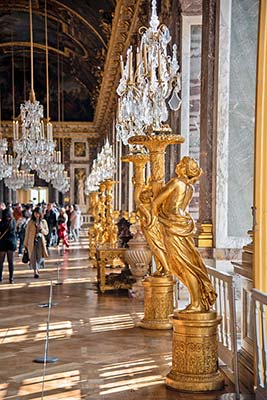
Château de Versailles
Trianon Palaces and Domaine de Marie-Antoinette
Map: Domaine de Marie-Antoinette
Every king’s dream, Versailles (vehr-sī) was the residence of French monarchs and the cultural heartbeat of Europe for about 100 years—until the Revolution of 1789 changed all that. The Sun King (Louis XIV) created Versailles, spending freely from the public treasury to turn his dad’s hunting lodge into a palace fit for the gods (among whom he counted himself). Louis XV and Louis XVI spent much of the 18th century gilding Louis XIV’s lily. In 1837, about 50 years after the royal family was evicted by citizen-protesters, King Louis-Philippe (then a constitutional monarch rather than a divine one) opened the palace as a museum. Today you can visit parts of the huge palace and wander through acres of manicured gardens sprinkled with fountains and studded with statues. Europe’s next-best palaces are just Versailles wannabes.
Worth ▲▲▲, Versailles offers three blockbuster sights. The main attraction is the palace itself, called the Château. Here you walk through dozens of lavish, chandeliered rooms once inhabited by Louis XIV and his successors, starring the magnificent Hall of Mirrors. Next come the expansive Gardens behind the palace, a landscaped wonderland crossed with footpaths and dotted with statues and fountains. Finally, at the far end of the Gardens, is the pastoral area called the Trianon Palaces and Domaine de Marie-Antoinette (a.k.a. Trianon/Domaine), a vast walled enclosure designed for frolicking blue bloods and featuring several small palaces and Marie’s Hamlet—perfect for getting away from the mobs at the Château.
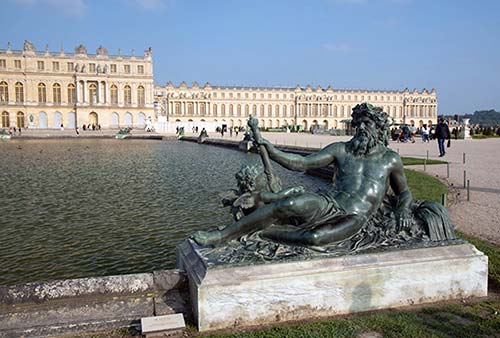
Visiting Versailles can seem daunting because of its size and hordes of visitors. The online reservation system is a work in progress (book well ahead, and expect lines and waits even with a reservation). But if you follow my tips, a trip here during even the busiest times is manageable.
By Train: You have two good rail options: Take the handy RER-C to the Versailles Rive Gauche/Château station, starting from any of these Paris stations: Gare d’Austerlitz, St. Michel, Musée d’Orsay, Invalides, Pont de l’Alma, or Champ de Mars (about a 35-minute train ride regardless of where you start, 15-minute walk to the Château). Or take the much faster SNCF train from Gare Montparnasse to Versailles-Chantiers station (12-minute train, then 25-minute walk or frequent 10-minute bus, Navigo passes valid). For either train option, use your Navigo Découverte pass, buy a four-zone all-day Easy pass, or, if paper tickets are still available, buy a round-trip ticket from a ticket machine or ticket window (about €8 round-trip).
If you take the RER-C, note that not all trains go to Versailles: Check the departure monitor over the tracks, which will list the next train to “Versailles Rive Gauche/Château.” To reach the Château from the Rive Gauche station, follow the flow: Turn right out of the station, then left at the first boulevard, and walk 10 more minutes.
To walk to the Château from the Chantiers station, exit straight out of the station and join Rue des Chantiers, then turn left on Avenue de Paris. Buses #40 and #401 stop outside the station and run near the Château.
Returning to Paris: To return to Paris on the RER-C line from the Versailles Rive Gauche/Château train station, just hop on the next train—all trains departing this station zip back to the city, stopping at all stations along line C. A video monitor shows how soon the next train leaves and from which track. And remember, your RER/Train-C ticket covers any connecting Métro ride once you’re back downtown. Returning via SNCF is straightforward: Make the trip back to the Chantiers station and take the next train to Gare Montparnasse.
By Taxi: The 30-minute ride (without traffic) between Versailles and Paris costs about €65.
By Tour: Minivan tours will pick you up at your hotel and whisk you painlessly to the Château and back. Paris Webservices tours are reliably good (around €120/person, RS%—see here for details). Big-bus tour companies offer Versailles day trips from Paris for around €35/person (transportation only) or about €90/person with guided tour and entry (get details at your hotel or www.pariscityvision.com).
By Car: Get on the périphérique freeway that circles Paris, and take the toll-free A-13 autoroute toward Rouen. Exit at Versailles, follow signs to Versailles Château, and avoid the hectic Garden lots by parking in the big pay lot at the foot of the Château on Place d’Armes (about €5/hour, €36/11 hours).
Versailles merits a full sightseeing day. In general, allow 1.5 hours each for the Château, the Gardens (includes time for lunch), and the Trianon/Domaine. Add another two hours for round-trip transit, and you’re looking at nearly an eight-hour day.
Versailles is all about crowd management; a well-planned visit can make or break your experience. Take this advice to heart. Versailles is much more enjoyable with a relaxed, unhurried approach. Here’s what I’d do on a first visit to avoid the worst lines and crowds:
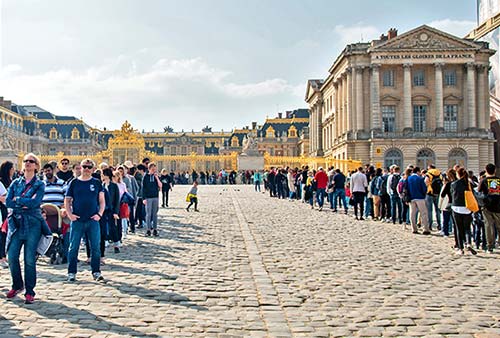
• Get an individual ticket or Le Passeport pass in advance and choose your Château entry time (see below). If you have a Paris Museum Pass, you have several options—see “Using the Paris Museum Pass,” later.
• Avoid holidays, Sundays, Tuesdays, and Saturdays—in that order—when crowds smother the palace interior. Thursdays and Fridays are best.
• Book an entry as close to opening time (9:00) as possible. Follow my self-guided tour of the Château interior, have lunch, then spend the afternoon touring the Gardens and the Trianon Palaces/Domaine de Marie-Antoinette. To shorten your visit, skip the Trianon/Domaine—beyond the 1.5 hours needed to see, it’s a 30-minute walk each way.
• An alternate plan is to book a midafternoon Château entry and visit the Gardens and Trianon/Domaine first. The Gardens open at 8:00, but the Trianon/Domaine doesn’t open until noon. If you arrive at around 10:00 or 10:30, you can devote some time to exploring the Gardens and hit the Trianon/Domaine just as it opens. You’ll then have the half-hour walk back to the Château, though you can take the petit train tram back if seats are available (see the “Getting Around the Gardens” sidebar later in this chapter).
Cost and Reservations: A timed-entry ticket is required to enter the Château. Reserve ahead and book your entry time on the Versailles website. If you have a Paris Museum Pass, see “Using the Paris Museum Pass,” later. Expect to wait in line even with a timed-entry reservation.
Château: €19.50 (Château only) or €21.50 Le Passeport ticket (includes Trianon/Domaine; €28 on Garden Spectacle days), both tickets come with timed entry. Free for kids 17 and under, and free on the first Sun of the month Nov-March.
Trianon Palaces and Domaine de Marie-Antoinette: €12, covers all the buildings within this walled enclosure. Free for kids 17 and under, and free on the first Sun of the month Nov-March.
Gardens: Free on weekdays April-Oct if there are no events in the Gardens (events require admission on weekends and most Tue and Fri—see “Spectacles in the Gardens,” later). The Gardens are free every day Nov-March. You can enter the Gardens directly from the passageway to the left of the main Château entrance (see the “Versailles Château” map).
Hours: The Château is open Tue-Sun 9:00-18:30, Nov-March until 17:30, closed Mon year-round.
The Trianon Palaces and Domaine de Marie-Antoinette are open Tue-Sun 12:00-18:30, Nov-March until 17:30, closed Mon year-round (off-season only the two Trianon Palaces and the Hamlet are open, not other outlying buildings), last entry 45 minutes before closing.
The Gardens are open daily 8:00-20:30, Nov-March until 18:00, but may close earlier for special events.
Information: Use the website to book your entry and check for updates—www.chateauversailles.fr. The free Versailles app includes interactive maps. The palace’s general contact number is +33 1 30 83 78 00. At the Château, an information office is to the left as you face the palace.
Using the Paris Museum Pass: The Paris Museum Pass covers the most important parts of the complex (Château and Trianon/Domaine); it does not include the Gardens on Spectacle days. To enter the Château using the pass, you must book an entry time (“Palace Ticket”—free) on the Versailles website.
Buying Tickets in Versailles: If you arrive in Versailles without a pass or ticket, you’ll have to wait (sometimes hours or days) to enter the Château. You can try booking an entry time on the spot, using your phone. Otherwise, try these options:
The Versailles TI sells tickets (10 percent fee; across from the Rive Gauche station on Place Lyautey, open Tue-Sun 10:00-17:00, closed Mon).
Get Your Guide usually has space on its guided tours (€59—twice the price of booking your own tickets and touring yourself), which include entry to the Château but not the Domaine de Marie-Antoinette or Gardens if it’s a fee day. Their office is across from the Rive Gauche station, under the stone arch at #10, www.getyourguide.co.uk).
Your last option is the busy Château ticket-sales office (to the left as you face the palace). Ticket windows accept American credit cards. Once you know your entry time, you can kill time by wandering the gardens.
Security Checkpoints: There are two security checkpoints: at the Château’s courtyard entry and again at the Château entrance (longest lines 10:00-12:00).
Pickpockets: Assume pickpockets are working the tourist crowds.
Tours: The 1.5-hour English guided tour of the Château gives you access to a few extra rooms (the itinerary varies) and lets you skip the security line at the Château entrance (€10, generally at least 3 tours in English between 9:00 and 15:00 April-Oct; off-season likely only at 9:30 and 14:00). Book in advance on the palace website.
Instead of paying €5 for the audioguide, download it in advance onto your phone for free using the “Palace of Versailles” app.
 Download my free Versailles audio tour. (Note that my tour and the official audioguide complement each other—”A” students enjoy listening to both.)
Download my free Versailles audio tour. (Note that my tour and the official audioguide complement each other—”A” students enjoy listening to both.)
Spectacles in the Gardens: The Gardens and fountains at Versailles come alive at selected times, offering a glimpse into Louis XIV’s remarkable world. The Sun King had his engineers literally reroute a river to fuel his fountains and feed his plants. Even by today’s standards, the fountains are impressive. Check the Versailles website for current hours and to find out what else might be happening during your visit.
The Gardens’ fountains are in full squirt during a production called Les Grandes Eaux Musicales, with 55 fountains gushing for an hour in the morning and up to two hours in the afternoon; individual fountains run periodically throughout the day (the impressive Neptune fountain runs every 15 minutes); it’s all accompanied by loud classical music (€10.50; April-Oct Sat-Sun 11:00-12:00 & 15:30-17:00, also Tue May-June 11:00-12:00 & 14:30-16:30). On varied weekdays April-Oct, you get the music but no fountains (called Les Jardins Musicaux, €10). For all garden events, check www.chateauversailles.fr. Pay or show proof of payment at the entrance to the Gardens.
And finally, on Saturday nights in summer, Les Grandes Eaux Nocturnes lets you meander past a thousand lights, illuminated groves, and shimmering pools while the fountains play to the sound of the Sun King’s music. Your experience ends with a firework show over the largest fountain pool (€31, Sat early June-mid-Sept 20:30-23:00, fireworks at 22:50). On these nights, the Royal Serenade option lets you go into the palace with costumed characters (€44 combo-ticket).
Baggage Check: Free and located by the ticket sales office (left of the Château entry). You have to drop your bag off before entering the Château and must retrieve it one hour before closing (maximum size is the same as airline carry-on bags). Large bags and baby strollers are not allowed in the Château and the two Trianons (you can check your stroller and use a baby backpack).
Services: WCs are plentiful and well signed in the Château, but fewer and farther between in the Gardens.
Eating: Near the Château entry, the $ Grand Café d’Orléans offers good-value self-service meals (sandwiches and small salads, great for picnicking in the Gardens). In the Gardens, you’ll find several cafés and snack stands with fair prices. One is located near the Latona Fountain (less crowded) and others are in an atmospheric cluster at the Grand Canal (more crowds and more choices, including two restaurants).
Across from the train station, there’s a McDonald’s and a Starbucks. For more eating options in the town of Versailles, see the end of this chapter.
Starring: Luxurious palaces, endless gardens, Louis XIV, Marie-Antoinette, and the ancien régime.
On this self-guided tour, we’ll see the Château (the State Apartments of the king as well as the Hall of Mirrors), the landscaped Gardens in the “backyard,” and the Trianon Palaces and Domaine de Marie-Antoinette, located at the far end of the Gardens. If your time is limited or you don’t enjoy walking, you have my permission to skip the Trianon/Domaine, which is a hefty 30-minute hike (each way) from the Château.
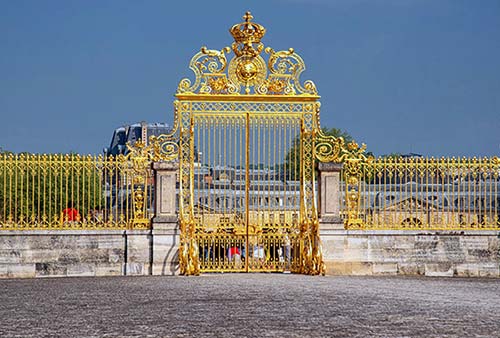
• Stand in the huge courtyard and face the palace. The golden Royal Gate in the center of the courtyard—nearly 260 feet long and decorated with 100,000 gold leaves—is a replica of the original. The entrance to the Château is marked Entrance A (where the line usually is). Before entering (or while standing in line), take in the Château and the open-air courtyard on the other side of the golden Royal Gate.
The section of the palace with the clock is the original château, once a small hunting lodge where little Louis XIV spent his happiest boyhood years. Naturally, the Sun King’s private bedroom (the three arched windows beneath the clock) faced the rising sun. The palace and grounds are laid out on an east-west axis.
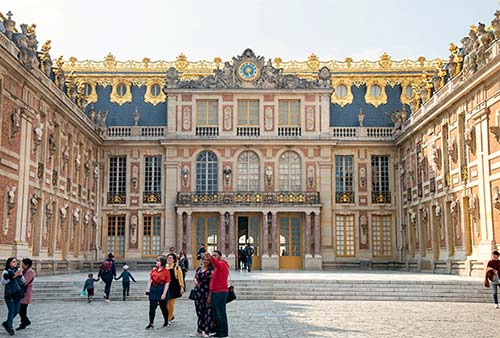
Once king, Louis XIV expanded the lodge by attaching wings, creating the present U-shape. Later, the long north and south wings were built. The total cost of the project has been estimated at half of France’s entire GNP for one year.
Think how busy this courtyard must have been 300 years ago. As many as 5,000 nobles were here at any one time, each with an entourage. Riding in sedan-chair taxis, they’d buzz from games to parties to amorous rendezvous. Servants ran about delivering secret messages and roast legs of lamb. Horse-drawn carriages arrived at the fancy gate with their finely dressed passengers, having driven up the broad boulevard that ran directly from Paris (the horse stables still line the boulevard). Incredible as it seems, both the grounds and most of the palace were public territory, where even the lowliest peasants could come to gawk—provided they passed through a metal detector and followed a dress code. Then, as now, there were hordes of tourists, pickpockets, palace workers, and men selling wind-up children’s toys.
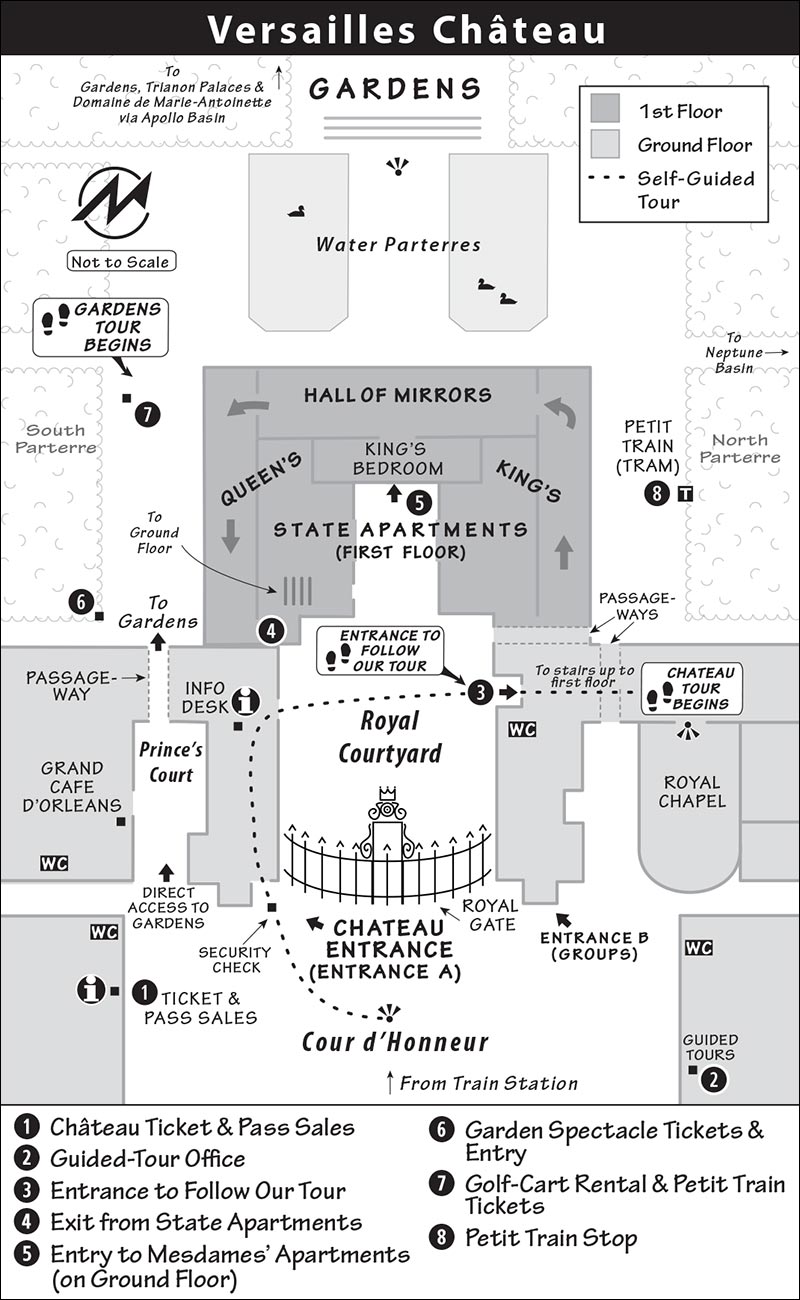
• As you enter the Château, you’ll find an information desk (get a map). Follow the crowds across the courtyard, where you’ll go back inside (the audioguide is available here). Now make your way to the start of our tour.
On the way, you’ll pass through a dozen ground-floor rooms. The first offers a glimpse through a doorway at the impressive Royal Chapel, which we’ll see again upstairs. The next rooms have interesting videos of palace history and models of Versailles at different stages of growth. The second floor has skippable paintings of Louis XIV, XV, XVI, and more. Climb the stairs and keep following the flow. You’ll eventually reach a palatial golden-brown room, with a doorway that overlooks the Royal Chapel. Let the tour begin.
Dut-dutta-dah! Every morning at 10:00, the organist and musicians struck up the music, these big golden doors opened, and Louis XIV and his family stepped onto the balcony to attend Mass. While Louis looked down on the golden altar, the lowly nobles on the ground floor knelt with their backs to the altar and looked up—worshipping Louis worshipping God. Important religious ceremonies took place here, including the marriage of young Louis XVI to Marie-Antoinette.
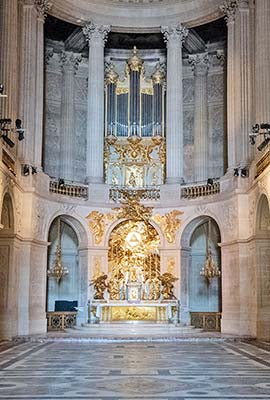
In the vast pagan “temple” that is Versailles—built to glorify one man, Louis XIV—this Royal Chapel is a paltry tip of the hat to that “other” god...the Christian one. It’s virtually the first, last, and only hint of Christianity you’ll see in the entire complex. Versailles celebrates Man, not God, by raising Louis XIV to almost godlike status, the personification of all good human qualities. In a way, Versailles is the last great flowering of Renaissance humanism and a revival of the classical world.
• Enter the next room, an even more sumptuous space with a fireplace and a colorful painting on the ceiling.
Pleasure ruled. The main suppers, balls, and receptions were held in this room. Picture elegant partygoers in fine silks, wigs, rouge, lipstick, and fake moles (and that’s just the men) as they dance to the strains of a string quartet.
On the wall opposite the fireplace is an appropriate painting showing Christ in the middle of a Venetian party. The work—by Paolo Veronese, a gift from the Republic of Venice—was one of Louis XIV’s favorites, so the king had the room decorated around it. Stand by the fireplace for the full effect: The room’s columns, arches, and frieze match the height and style of Veronese’s painted architecture, which makes the painting an extension of the room.
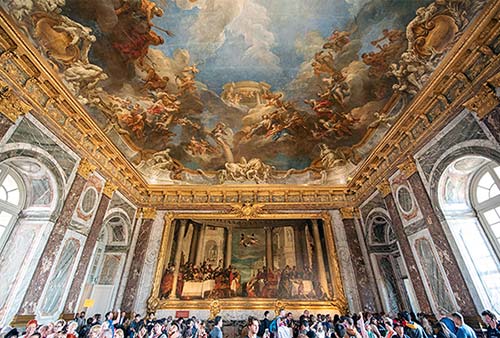
The ceiling painting, ringed by a balustrade, creates the effect of a sunroof opening up to heaven. Hercules (with his club) hurries up to heaven on a chariot, late for his wedding to the king of the gods’ daughter. The scene echoes real life—Louis XIV built the room for his own daughter’s wedding reception. The style is pure Baroque, a riot of 142 exuberant figures depicted at all angles by Louis’ court painter, Charles Le Brun.
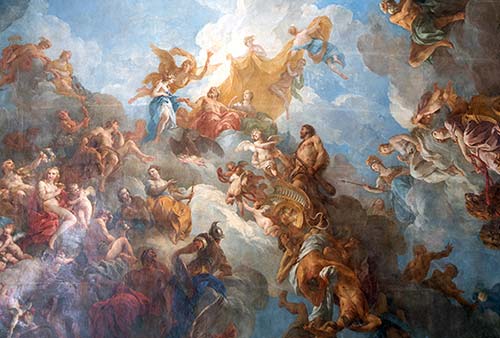
• From here on it’s a one-way tour—getting lost is not allowed. Follow the crowds into the small green room with a goddess in pink on the ceiling. The names of the rooms generally come from the paintings on the ceilings.
If the party in the Hercules Room got too intense, you could always step in here for some refreshments. Silver trays were loaded with liqueurs, exotic stimulants (coffee), juice, chocolates, and, on really special occasions, three-bean salad.
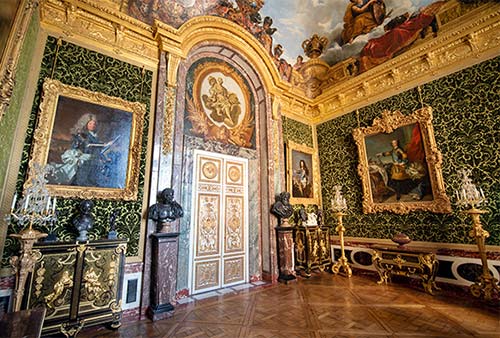
The ceiling painting shows the cornucopia of riches poured down on invited guests.
Around the edges of the ceiling are painted versions of the king’s actual treasures and royal dinnerware—golden bowls, urns, and gravy boats. The two black chests of drawers are from Louis’ furniture collection (most of it was lost in the Revolution). They rest on heavy bases and are heavily ornamented—the so-called Louis XIV style.
Louis himself might be here. He was a gracious host who enjoyed letting his hair down at night. If he took a liking to you, he might sneak you through those doors there (in the middle of the wall) and into his own private study, or “cabinet of curiosities,” where he’d show off his collection of dishes, medals, jewels, or...the Mona Lisa, which hung on his wall. Louis’ favorite show-and-tell items are now in the Louvre.
The paintings on the walls are of Louis XIV’s heirs. He reigned for more than 70 years and outlived three of them, finally leaving the crown to his pink-cheeked, five-year-old great-grandson, Louis XV (on the right).
Love ruled at Versailles. In this room, couples would cavort beneath the goddess of love floating on the ceiling. Venus sends down a canopy of flowery garlands to ensnare mortals in delicious amour. Another ceiling painting (above the statue, in a rectangular frame) symbolizes the marriage of Louis XIV and Marie-Thérèse, shown in their wedding-limo chariot.

Baroque artists loved to mix their media to fool the eye. Notice how in the paintings at both ends of the room, the painted columns match the real ones, extending this grand room into mythical courtyards.
Don’t let the statue of a confident Louis XIV as a Roman emperor fool you. He started out as a poor little rich kid with a chip on his shoulder. His father died before Louis was old enough to rule, and, during the regency period, the French parlements treated little Louis and his mother like trash. They were virtual prisoners, humiliated in their home, the Royal Palace in Paris (today’s Louvre). There they eked by with bland meals, hand-me-down leotards, and pointed shoes. After Louis XIV attained power and wealth, he made Versailles a pleasure palace, with happy hours held in this room every evening. There was one topic you never discussed in Louis’ presence: poverty. Maybe Versailles was his way of saying, “Living well is the best revenge.”
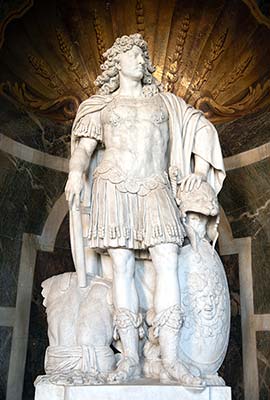
Here in the billiards room, Louis and his men played on a table that stood in the center of the room, while ladies sat surrounding them on Persian-carpet cushions, and music wafted in from next door. Louis was a good pool player, a sore loser, and a king—thus, he rarely lost.
The famous bust of Louis by Giovanni Lorenzo Bernini (in the center) shows a handsome, dashing, 27-year-old playboy-king. His gaze is steady amid his windblown cloak and hair. Young Louis loved life. He hunted animals by day (notice Diana the Huntress, with her bow, on the ceiling) and chased beautiful women at night.
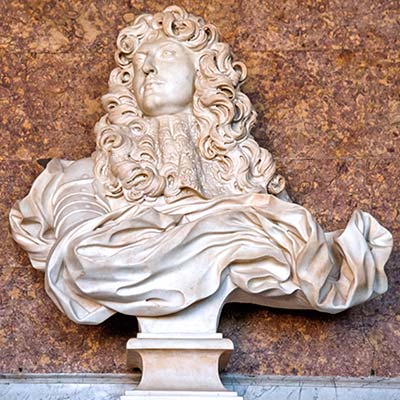
Games were actually an important part of Louis’ political strategy, known as “the domestication of the nobility.” By distracting the nobles with the pleasures of courtly life, he was free to run the government his way. Billiards, dancing, and concerts were popular, but the biggest distraction was gambling, usually a card game similar to blackjack. Louis lent money to the losers, making them even more indebted to him. The good life was an addiction, and Louis kept the medicine cabinet well-stocked.
As you move into the next room, notice the fat walls that hid thin servants, who were to be at their master’s constant call—but out of sight when not needed.
Also known as the Guard Room (as it was the room for Louis’ Swiss bodyguards), this red room is decorated with a military flair. On the ceiling is Mars, the Greek god of war, in a chariot pulled by wolves. The bronze cupids in the corners are escalating from love arrows to heavier artillery. But it’s not all war. Louis loved music and playing his guitar, and enjoyed concerts here in the Mars Room nearly every evening.
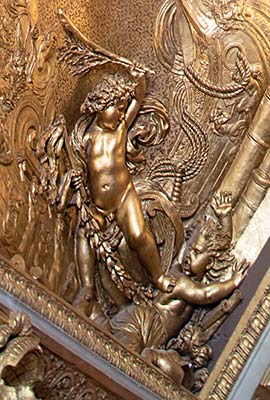
Out the window are sculpted gardens in the style of a traditional Italian villa—landscaped symmetrically, with trimmed hedges and cone-shaped trees lining walkways that lead to fountains.
As you wander, you’ll notice that the palace feels bare (except for the wall-to-wall tourists), but remember that entire industries were created to decorate the place with carpets, mirrors, furniture, and tapestries. Most of the furniture we see today is not original, but is from the same period.
Louis’ life was a work of art, and Versailles was the display case. Everything he did was a public event designed to show his subjects how it should be done. This room may have served as Louis’ official (not actual) bedroom, where the Sun King would ritually rise each morning to warm his subjects.
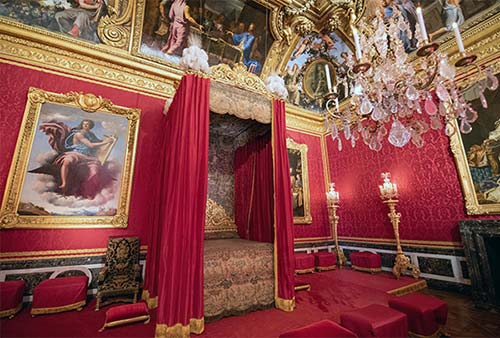
From a canopied bed (like this 18th-century one), Louis would get up, dress, and take a seat for morning prayer. Meanwhile, the nobles would stand and watch, in awe of his piety, nobility, and clean socks. At breakfast, they murmured with delight as he deftly decapitated his boiled egg with a knife. And when Louis went to bed at night, the dukes and barons would fight over who got to hold the candle while he slipped into his royal jammies. Bedtime, wake-up, and meals were all public rituals.
This was the grand throne room. Louis held court from a 10-foot-tall, silver-and-gold canopied throne on a raised platform placed in the center of the room (the platform is there, though not the throne). Even when the king was away, passing courtiers had to bow to the empty throne.
Everything in here reminds us that Louis XIV was not just any ruler, but the Sun King, who lit the whole world with his presence. On the ceiling, the sun god Apollo (representing Louis) drives his chariot, dragging the sun across the heavens to warm the four corners of the world (counterclockwise from above the exit door): 1) Europe, with a sword; 2) Asia, with a lion; 3) Africa, with an elephant; and 4) good ol’ America, a Native American maiden with a crocodile. Notice the ceiling’s beautifully gilded frame and Goldfinger maidens.
The famous portrait by Hyacinthe Rigaud over the fireplace gives a more human look at Louis XIV. He’s shown in a dancer’s pose, displaying the legs that made him one of the all-time dancing fools of kingery (see a photo of this portrait on here). At night, they often held parties in this room, actually dancing around the throne.
Louis XIV (who was 63 when this was painted) had more than 300 wigs like this one, and he changed them many times a day. This fashion first started when his hairline began to recede, then sprouted all over Europe, and even spread to the American colonies in the time of George Washington.
Louis XIV may have been treated like a god, but he was not an overly arrogant man. His subjects adored him because he was a symbol of everything a man could be, the fullest expression of the Renaissance Man. Compare the portrait of Louis XIV with the one across the room of his last successor, Louis XVI—same arrogant pose, but without the inner confidence to keep his head on his shoulders.
• Continue into the final room of the King’s Wing.
“Louis Quatorze was addicted to wars,” and the room depicts his victories—in marble, gilding, stucco, and paint. France’s success made other countries jealous and nervous. At the base of the ceiling (in semicircular paintings), we see Germany (with the double eagle), Holland (with its ships), and Spain (with a red flag and roaring lion) ganging up on Louis XIV. But Lady France (center of ceiling), protected by the shield of Louis XIV, hurls thunderbolts down to defeat them. The relief on the wall shows Louis XIV on horseback, triumphing over his fallen enemies.
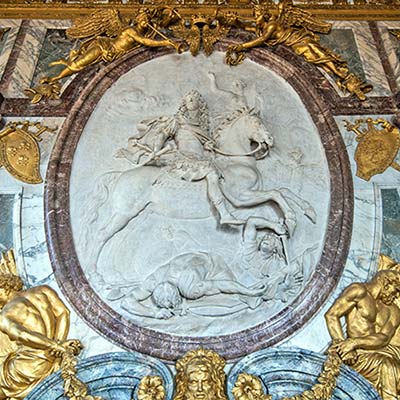
Versailles was good propaganda. It showed the rest of the world how rich and powerful France was. A visit to the Château and Gardens sent visitors reeling. And Louis XIV’s greatest triumph may be the next room, the one that everybody wrote home about.
No one had ever seen anything like this hall when it was opened. Mirrors were still a great luxury at the time, and the number and size of these monsters was astounding. The hall is nearly 250 feet long. There are 17 arched mirrors, matched by 17 windows letting in that breathtaking view of the Gardens. Lining the hall are 24 gilded candelabra, eight busts of Roman emperors, and eight classical-style statues (seven of them ancient). The ceiling decoration chronicles Louis’ military accomplishments, topped off by Louis himself in the central panel (with cupids playing cards at his divine feet) doing what he did best—triumphing. Originally, two huge carpets mirrored the action depicted on the ceiling.
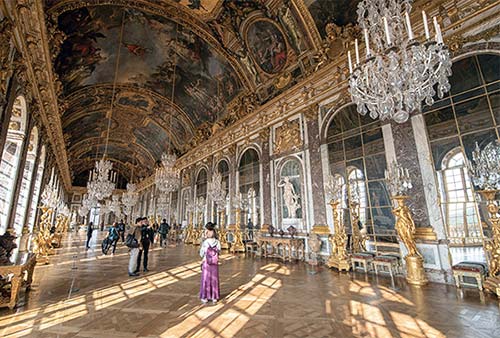
Imagine this place lit by the flames of thousands of candles, filled with ambassadors, nobles, and guests dressed in silks and powdered wigs. At the far end of the room sits the king, on the canopied throne moved in temporarily from the Apollo Room. Servants glide by with silver trays of hors d’oeuvres, and an orchestra fuels the festivities. The mirrors reflect an age when beautiful people loved to look at themselves. It was no longer a sin to be proud of good looks and fine clothes, or to enjoy the good things in life: laughing, dancing, eating, drinking, flirting, and watching the sun set into the distant canal.
From the center of the hall you can fully appreciate the epic scale of Versailles. The huge palace (by architect Louis Le Vau), the fantasy interior (by Charles Le Brun), and the endless gardens (by André Le Nôtre) made Versailles le best. In 1871, after the Prussians defeated the French, Otto von Bismarck declared the establishment of the German Empire in this room. And in 1919, Germany and the Allies signed the Treaty of Versailles, ending World War I (and, some say, starting World War II) right here, in the Hall of Mirrors.
• Backtrack a few stops to find the door that leads into the heart of the palace, to the...
Pass through a first large room to find Louis XIV’s bedroom. It’s elaborately decorated, and the decor changed with the season. On the wall behind the impressive bed, a golden Lady France watched over her king as he slept. The balustrade separated the courtiers from the king. Though this was Louis’ actual bedroom, it was also a somewhat public space where he received visitors. The two rooms on either side of the bedroom—right next to where the king slept—were large halls for ambassadorial receptions and cabinet meetings.

Find an uncovered window and notice how this small room is at the exact center of the immense horseshoe-shaped building, overlooking the main courtyard and—naturally—facing the rising sun in the east. It symbolized the exact center of power in France. Imagine the humiliation on that day in 1789 when Louis’ great-great-great-grandson, Louis XVI, was forced to stand here and acknowledge the angry crowds that filled the square demanding the end of the divine monarchy.
• Return to the Hall of Mirrors, and continue to the end, being sure to enjoy views of the garden. Enter the...
By the end of the Sun King’s long life, he was tired of fighting. In this sequel to the War Room, peace is granted to Germany, Holland, and Spain as cupids play with the discarded cannons, and swords are transformed into violins. Louis XIV advised his great-grandson to “be a peaceful king.”
The oval painting above the fireplace shows 19-year-old Louis XV bestowing an olive branch on Europe. Beside him is his Polish wife, Marie Leszczyńska, cradling their baby twin daughters. On Sundays the queen held chamber-music concerts here for family and friends (notice the gilded music motifs).
• The Peace Room marks the beginning of the suite of rooms where France’s queens lived, slept, ate, and entertained.
The Queen’s Wing is a mirror image of the King’s Wing. The King’s Wing was mostly ceremonial and used as a series of reception rooms; the Queen’s Wing is more intimate.
• Enter the first room of the Queen’s Wing, with its canopied bed.
It was here that the queen rendezvoused with her husband. Two queens died here, and this is where 19 princes were born. The chandelier is where two of them were conceived. (Just kidding.) Royal babies were delivered in public to prove their blue-bloodedness.
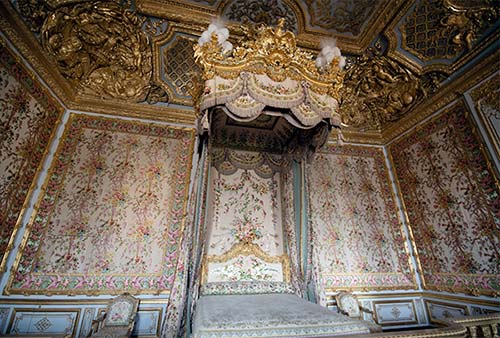
True, Louis XIV was not the most faithful husband. There was no attempt to hide the fact that the Sun King warmed more than one bed, for he was above the rules of mere mortals. Adultery became acceptable—even fashionable—in court circles. The secret-looking door on the left side of the bed was for Louis’ late-night liaisons—it led straight to his rooms.
Some of Louis XIV’s mistresses became more famous and powerful than his rather quiet queen, but he was faithful to the show of marriage and had genuine affection for his wife. Louis XIV made a point of sleeping with the queen as often as possible, regardless of whose tiara he tickled earlier in the evening.
This room looks just like it did in the days of the last queen, Marie-Antoinette, who substantially redecorated the entire wing. That’s her bust over the fireplace, and the double eagle of her native Austria in two of the corners. The big mahogany chest to the left of the bed held her jewels.
The large canopied bed is a reconstruction. The bed, chair, and wall coverings switched with the seasons. This was the cheery summer pattern.
Here, in this mint green room, the wife of Louis XV and her circle of friends met, under paintings by Boucher—popular with the queen for their pink-cheeked Rococo exuberance. Discussions ranged from politics to gossip, food to literature, fashion to philosophy. All three of Versailles’ rulers considered themselves enlightened monarchs who promoted the arts and new ideas. Louis XIV laughed at the anti-authoritarian plays of Molière, and Louis XV gave free room and board here to the political radical Voltaire. Ironically, these discussions planted the seeds of liberal thought that would grow into the Revolution.
The royal family dined publicly in this room (also called the Grand Couvert), while servants and nobles fluttered around them, admired their table manners, and laughed at the king’s jokes. A typical dinner consisted of four soups, two whole birds stuffed with truffles, mutton, ham slices, fruit, pastries, compotes, and preserves.

You may see a portrait of luxury-loving, “let-them-eat-cake” Marie-Antoinette, who became a symbol of decadence to the peasants. The portrait at the far end is a public-relations attempt to soften her image by showing her with three of her children.
On October 5, 1789, a mob of revolutionaries—perhaps appalled by their queen’s taste in wallpaper—stormed the palace. They were fed up with the ruling class leading a life of luxury in the countryside while they were starving in the grimy streets of Paris.
The king and queen locked themselves in. Some of the revolutionaries gained access to this upper floor. They burst into this room where Marie-Antoinette was hiding, overcame her bodyguards, and dragged her off along with her husband. (Some claim that, as they carried her away, she sang, “Louis, Louis, oh-oh...we gotta go now.”)
The enraged peasants then proceeded to ransack the place as revenge for the years of poverty and oppression they’d suffered. (The stripped palace was refurnished a decade later under Napoleon and eventually turned into a national museum.) Marie-Antoinette and Louis XVI were later taken to Place de la Concorde in Paris, where they knelt under the guillotine and were made a foot shorter at the top.
Did the king and queen deserve it? Were the revolutionaries destroying civilization or clearing the decks for a new and better one? Was Versailles a symbol of progress or decadence?
No sooner did the French throw out a king than they got an emperor. The Revolution established democracy, but it was shaky in a country that wasn’t used to it. In the midst of the confusion, the upstart general Napoleon Bonaparte took control and soon held dictatorial powers.
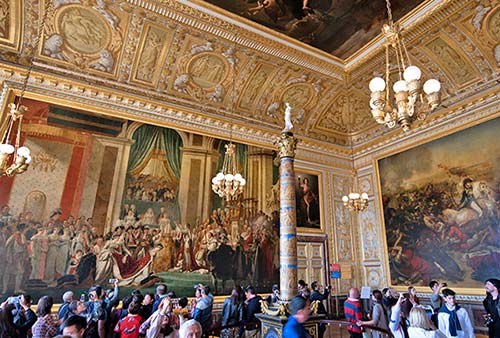
This room captures the glory of the Napoleonic years, when Bonaparte conquered most of Europe. In the huge canvas, we see him crowning himself emperor of a new, revived “Roman” Empire. (The original by Jacques-Louis David now hangs in the Louvre; this is a later but lesser-quality copy by the master himself.)
Turn and face the windows to see the portrait (between the windows on the right) of a dashing, young, charismatic Napoleon in 1796, when he was just a general in command of the Revolution’s army in Italy. Above the young Napoleon is a portrait of Josephine—his wife and France’s empress. Compare the young Napoleon with the adjacent portrait from 10 years later—looking less like a revolutionary and more like a Louis. Above the older Napoleon is a portrait of Empress Marie-Louise, his second wife.
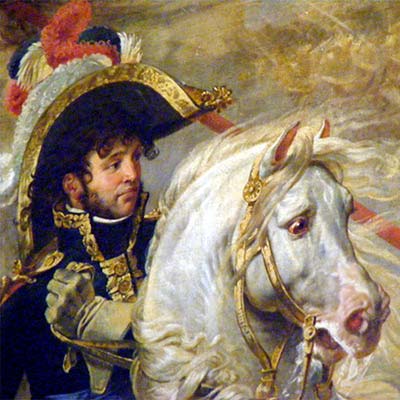
In David’s Distribution of Eagles (opposite the Coronation), the victorious general, in imperial garb, passes out emblems of victory to his loyal troops. In The Battle of Aboukir (opposite the window, see photo), Joachim Murat, Napoleon’s general and brother-in-law, looks bored as he slashes through a tangle of dark-skinned warriors. His horse, though, has a look of, “What are we doing in this mob? Let’s get out of here!” Let’s.
• This ends our tour of the Château. From here, head down the stairs, skipping the long gallery of famous French battles. Consider a break in the Salon de Thé Angelina, with a self-service sandwich bar, and an elegant sit-down restaurant featuring a decadent hot chocolate and the Mont Blanc—a chestnut-cream meringue with whipped cream.
Continuing downstairs to the exit, you’ll reach the audioguide-return desk and WCs.
Exit the palace (once you leave, you can’t return without going through security again) and turn right into the Gardens (les Jardins), located behind the Château.
Louis XIV was a divine-right ruler. One way he proved it was by controlling nature like a god. These lavish grounds—elaborately planned, pruned, and decorated—showed everyone that Louis was in total command. Louis loved his gardens and, until his last days, presided over their care. He personally led VIPs through them and threw his biggest parties here. With their Greco-Roman themes and incomparable beauty, the Gardens further illustrated his immense power.
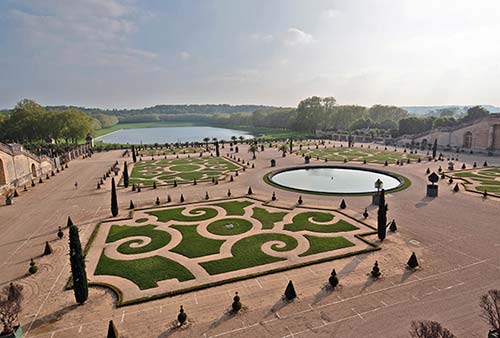
The Gardens are vast. For some, a stroll through the landscaped shrubs around the Château and quick view down the Royal Drive is plenty. But it’s worth the 10-minute walk down the Royal Drive to the Apollo Basin and back (even if you don’t continue further to the Trianon/Domaine). To trace the route of this tour, see the “Versailles” map earlier in this chapter.
• Entering the Gardens, make your way into the king’s spacious backyard. Angling right, you’ll pass by artificial ponds, reclining river-god statues, and cookie-cutter patterns of shrubs and green cones. As you walk, consider that a thousand orange trees were once stored beneath your feet in greenhouses. On sunny days, they were wheeled out in their silver planters and scattered around the grounds. The warmth from the Sun King was so great that he could even grow orange trees in chilly France.
You’ll eventually reach the top step of a staircase overlooking the Gardens. Face away from the palace and take in the jaw-dropping...
This, to me, is the most stunning spot in all of Versailles. With the palace behind you, it seems as if the grounds stretch out forever. Versailles was laid out along an eight-mile axis that included the grounds, the palace, and the town of Versailles itself, one of the first instances of urban planning since Roman times and a model for future capitals, such as Washington, DC, and Brasilia.
Looking down the Royal Drive (also known as “The Green Carpet”), you see the round Apollo fountain in the distance. Just beyond that is the Grand Canal. The groves on either side of the Royal Drive were planted with trees from all over, laid out in an elaborate grid, and dotted with statues and fountains. Of the original 1,500 fountains, 300 remain.
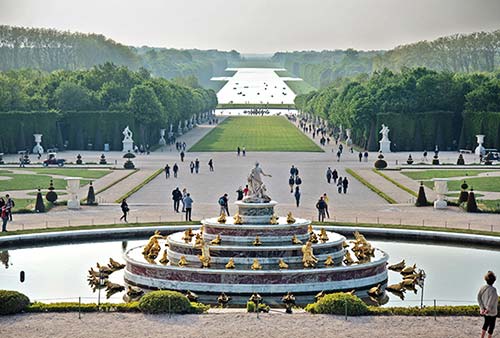
Looking back at the palace, you can see the Hall of Mirrors—it’s the middle story, with the arched windows.
• Stroll down the steps to get a good look at the frogs and lizards that fill the round...
Everything in the garden has a symbolic meaning. The theme of Versailles is Apollo, the god of the sun, associated with Louis XIV. This round fountain tells the story of the birth of Apollo and his sister, Diana. On top of the fountain are Apollo and Diana as little kids with their mother, Latona (they’re facing toward the Apollo fountain). Latona, an unwed mother, was insulted by the local peasants. She called on the king of the gods, Zeus (the children’s father), to avenge the insult. Zeus swooped down and turned all the peasants into the frogs and lizards that ring the fountain.
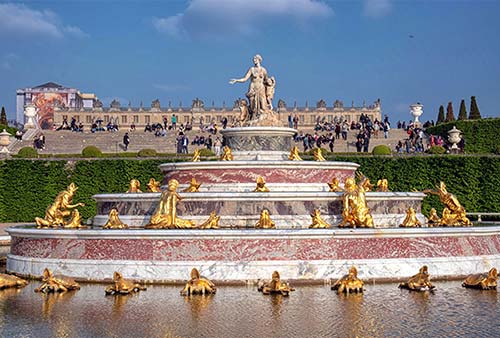
• As you walk down past the basin toward the Royal Drive, you’ll pass by “ancient” statues done by 17th-century French sculptors. You’ll see statues of gods, nymphs, mythological heroes, allegories of the seasons, and huge Roman-style vases. A cheap snack kiosk and WCs are close by. Find the Colonnade, hidden in the woods on the left side of the Royal Drive, about three-fourths of the way to the Apollo Basin (you’ll spot it off the main path through an opening).
Versailles had no prestigious ancient ruins, so the king built his own. This prefab Roman ruin is a 100-foot circle of 64 red-marble columns supporting pure white arches. The arches are decorated with cherubs playing harps. In the center stands a statue of Pluto (Greek god of the Underworld) carrying off Proserpine while her mom gets trampled. Surrounding the whole thing are small birdbath fountains (imagine them all spouting water). Nobles would picnic in the shade to the tunes of a string quartet and pretend that they were the enlightened citizens of the ancient world.
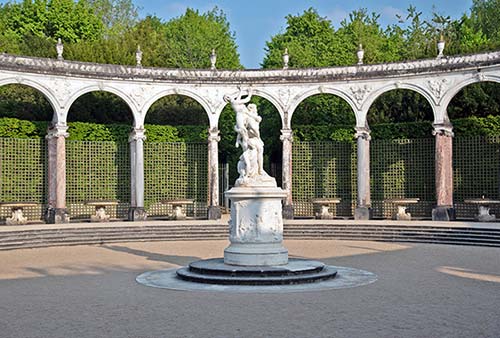
The fountains of Versailles were once its most famous attraction, a marvel of both art and engineering. This one was the centerpiece, showing the sun god—Louis XIV—in his sunny chariot as he starts his journey across the sky. The horses are half-submerged, giving the impression, when the fountains play, of the sun rising out of the mists of dawn. Apollo’s entourage includes dolphins leading the way and Tritons blowing their conch shells. Most of the fountains were turned on only when the king walked by, but this one played constantly for the benefit of those watching from the palace. Look into the water to see the substantial pipes that feed this powerful fountain.

All the fountains are gravity-powered. They work on the same principle as blocking a hose with your finger to make it squirt. Underground streams (pumped into Versailles by Seine River pressure) feed into smaller pipes at the fountains, which shoot the water high into the air.
Looking back at the palace from here, realize that the distance you just walked is only a fraction of this vast complex of buildings, gardens, and waterways. Be glad you don’t have to mow the lawn.
Why visit Venice when you can just build your own? In an era before virtual reality, this was the next best thing to an actual trip. Couples in gondolas would pole along the waters accompanied by barges with orchestras playing “O Sole Mio.” The canal is actually cross-shaped; you’re looking at the longest part, one mile from end to end. Of course, this, too, is a man-made body of water with no function other than to please. Originally, authentic gondoliers, imported with their boats from Venice, lived in a little settlement next to the canal.
These days, the Grand Canal hosts eateries, rental boats, bike and golf-cart rentals, and a petit train tram stop (see the “Getting Around the Gardens” sidebar, earlier).
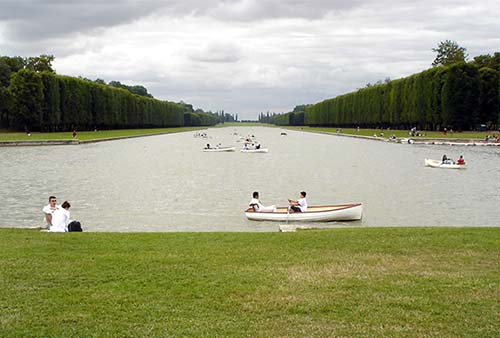
• Next stop, the Trianon Palaces and Domaine de Marie-Antoinette, a walled-off part of the Gardens accessible only with a ticket. To get to our tour’s starting point at the Grand Trianon, veer right past the second Grand Canal restaurant (see the “Versailles” map, earlier), and follow the dirt path along a looooong, tree-lined strip of lawn that leads uphill 500 yards to the Grand Trianon (a 15-minute walk). It’s possible to take a bike, golf cart, or petit train as far as the Grand Trianon entry, but you’ll need to walk inside.
Versailles began as an escape from the pressures of kingship. But in a short time, the Château became as busy as Paris ever was. Louis XIV needed an escape from his escape, so he built a smaller palace out in the boonies. Later, his successors retreated still farther from the Château and French political life, ignoring the real world that was crumbling all around them. They expanded the Trianon area, building a fantasy world of palaces, ponds, pavilions, and pleasure gardens—the enclosure called Marie-Antoinette’s Domaine.
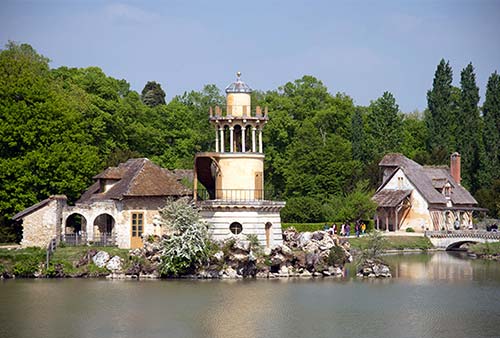
If you’re monitoring your time and energy, note that it’s a 1.5-hour commitment to see the whole Trianon/Domaine, plus a 30-minute walk back to the Château.
• You can enter/exit at only three spots: near the palace known as the Grand Trianon (where we’ll enter), near the Petit Trianon palace, or way around back on the far side of the Hamlet.
• Enter the Grand Trianon and pass through its security checkpoint. Pick up the free palace brochure and follow the simple one-way route through the rooms (basic English information posted in most rooms). Read your flier as you follow this tour to get the most out of your visit (some rooms may be closed).
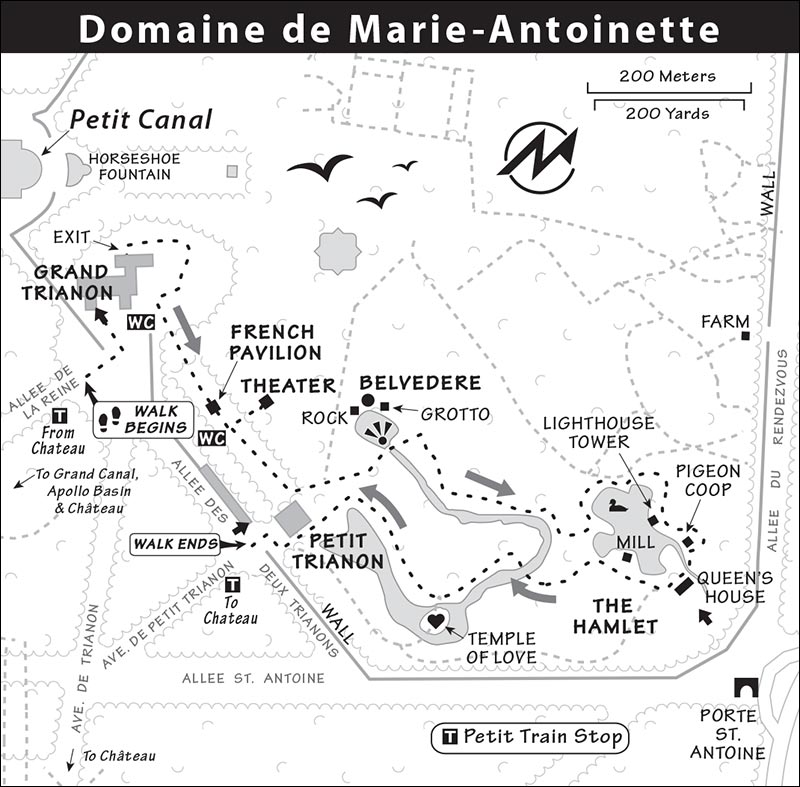
Delicate, pink, and set amid gardens, the Grand Trianon was the perfect summer getaway. This was the king’s private residence away from the main palace. Louis XIV usually spent a couple of nights a week here (more in the summer) to escape the sniping politics, strict etiquette, and 24/7 scrutiny of official court life.
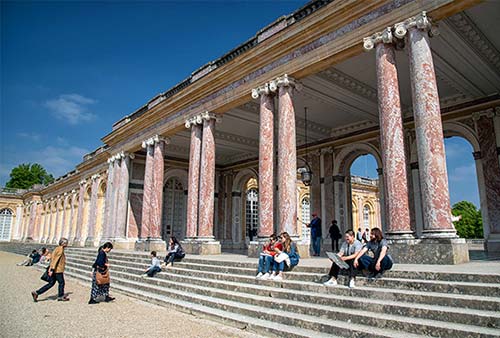
Louis XIV built the palace (1670-1688) near the tiny peasant village of Trianon (hence the name) and faced it with blue-and-white ceramic tiles. When those began disintegrating almost immediately, the palace was renovated with pink marble. It’s a one-story structure of two wings connected by a colonnade, with gardens in back.
The rooms are a complex overlay of furnishings from many different kings, dauphins, and nobles who lived here over the centuries. Louis XIV alone had three different bedrooms. Concentrate on the illustrious time of Louis XIV (1688-1715) and Napoleon Bonaparte (1810-1814). Use your map (which has room numbers on it) to find these highlights.
• From the gift shop, pass down a long hall to the Boudoir of the Empress (Room 1) and the...
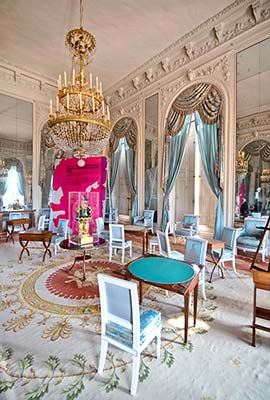
Mirrors Salon (Room 2): This spacious living room has the original white walls and mirrors of Louis XIV, and the Empire-style furniture of Napoleon (unornamented, high-polished wood, with classical motifs). Napoleon inhabited the Grand Trianon with his second wife, Empress Marie-Louise, and his mother—the women in the left wing, the emperor in the right.
Bedroom of the Empress (Room 3): This spacious red-and-white room is best known as being Louis XIV’s bedroom. Louis built the Grand Trianon as home for his chief mistress, while his wife lived in the Château. Imagine waking up in this big bed with your lover, throwing back the curtain, and looking out the windows at the gardens. These light, airy, many-windowed rooms were cheery even when skies were gray, a strong contrast to the heavy-metal decor in the mother Château. The adjoining room (divided by classical columns) was the dressing room.
• Pass through Rooms 4 and 5, and exit into the open-air colonnade (Peristyle) that connects the two wings. Originally, this pink-columned passageway had windows, an enormously expensive luxury that allowed visitors to enjoy the gardens even in bad weather. Entering the right wing of the palace, you walk across the impressive red-white-black marble floor of the Round Salon (Room 6), and detour right (if open) to find the...
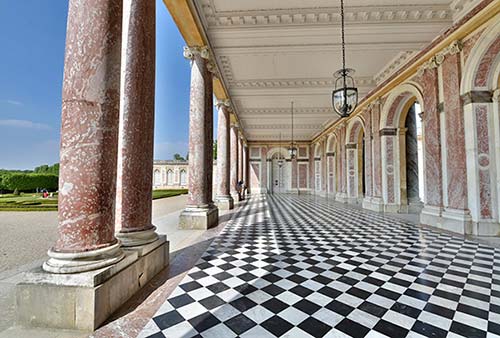
Emperor’s Family Drawing Room (Room 7): This room had many different uses over the years: a theater for Louis XIV, a game room for Louis XV, and Napoleon’s family room. After Napoleon was defeated and France’s royalty returned, King Louis-Philippe I lived here. In Room 8, admire the impressive canopied bed.
• Backtrack to the Round Salon and continue on through a series of rooms, passing through Louis-Philippe’s billiards room, until you reach a room decorated in green malachite.
Malachite Room (Room 11): This was Napoleon’s living room, and his library was next door. You’ll see the impressive green basin, vases, and candelabras made of Russian malachite given to Napoleon by Czar Alexander I. Another czar, Peter the Great, who lodged in the Grand Trianon in 1717 and then returned home, was inspired to build the Peterhof—a similarly lavish summer palace near St. Petersburg known as the “Russian Versailles.”
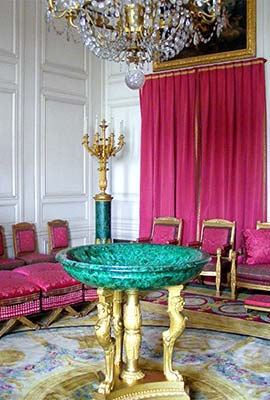
• Next, amble through the elegant Cotelle Gallery, with works that show the gardens in the 17th century, then exit into the gardens. Look back. The facade of pink, yellow, and white is a welcome contrast to the imposing Baroque facade of the main palace. The landscaping is similar to the Château—cone-shaped trees, ponds, and hedges—but everything is mini-sized. The flower gardens were changed daily for the king’s pleasure—for new color combinations and new “nasal cocktails.”
• Our next stop is the French Pavilion. To get there from the Grand Trianon gardens, walk clockwise around the perimeter of the Grand Trianon. Make it a tight, 180-degree loop, hugging the palace on your right, and follow signs to the Petit Trianon. A path leads across a footbridge. Directly ahead, you’ll see the...
This small, cream-colored building (generally closed) with rooms fanning out from the center was one more step away from the modern world. Inside is a circular room with four small adjoining rooms. With its red-white-gold decor, flower-draped chandelier, and starburst floor, it’s a small jewel of interior design. Big French doors let in a cool breeze. Here Marie-Antoinette spent summer evenings with family and a few friends, listening to music or playing parlor games. She and her friends explored all avenues of la douceur de vivre, the sweetness of living.
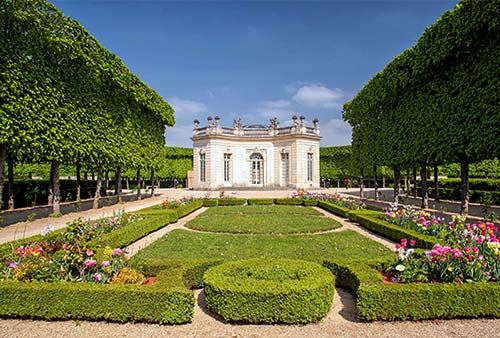
• Up ahead is the large, cube-shaped Petit Trianon palace. Head toward the Petit Trianon, but midway there, turn left, where you can peek into...
Marie-Antoinette adored the theater and was an aspiring performer herself. In this intimate playhouse, far from the rude intrusions of the real world, the queen and her friends acted out plays. The soft blue decor, gold trim, and upholstered walls and benches give the theater a dollhouse feel. Though small, it has everything you’d find in a major opera house: stage, orchestra pit, balconies, a painted backdrop setting a peasant scene, ornate gold ceiling, and raked seating for 100.
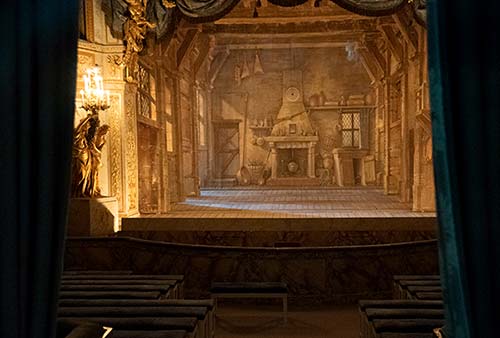
• Continue to the Petit Trianon, through the oh-so-bucolic gardens. If you’d like to cut this tour short, you could skip ahead and visit the Petit Trianon now. Otherwise, turn left and follow paths uphill to a pond graced with a tiny palace.
The octagonal Belvedere palace is as much windows as it is walls. When the doors were open, it could serve as a gazebo for musicians, serenading nobles in this man-made alpine setting. The interior has a marble-mosaic floor and walls decorated with birds and delicate, Pompeii-esque garlands. To the left of the Belvedere is the “Rock,” a fake mountain that pours water into the pond. To the right of the Belvedere (you’ll have to find it) is the secret Grotto.
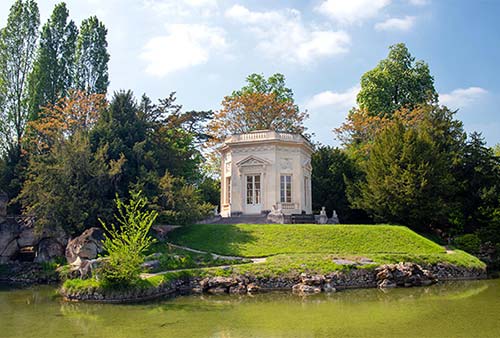
• Facing the Belvedere, turn right (east), following the pond’s meandering stream. Continue gamboling along the paths. In the distance you’ll spy a complex of buildings, with a round, fanciful tower and a smattering of rustic, half-timbered buildings. Head there to find the Hansel-and-Gretel-like...
Marie-Antoinette longed for the simple life of a peasant—not the hard labor of real peasants, who sweated and starved around her, but the fairy-tale world of simple country pleasures. She built this complex of 12 thatched-roof buildings fronting a lake as her own private “Normand” village.
The main building is the Queen’s House—actually two buildings connected by a wooden skywalk. It’s the only one without a thatched roof. Like any typical peasant farmhouse, it had a billiard room, library, elegant dining hall, and two living rooms.
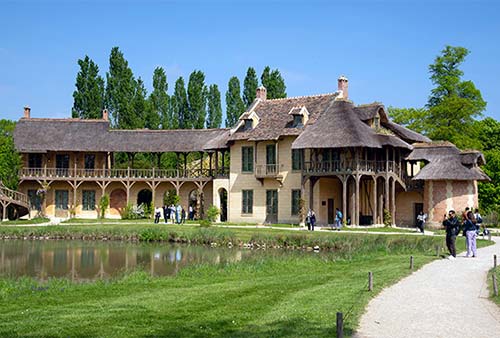
This was an actual working farm with a dairy (walk past the lighthouse tower), a water mill, a pigeon coop (in a thatched cottage called Le Colombier), and domestic animals. Beyond the lighthouse tower (La Tour de Marlborough—departure point for boat trips on the pond), you’ll see where the queen’s servants kept cows, goats, chickens, and ducks. The harvest was served at Marie-Antoinette’s table. Marie-Antoinette didn’t do much work herself, but she “supervised,” dressed in a plain, white muslin dress and a straw hat. Though the royal family is long gone, kid-pleasing animals still inhabit the farm, and beaucoup fat fish swim languid circles in the pond.
• Head back toward the Petit Trianon. Along the way (in about five minutes), you’ll see the white dome of the...
A circle of 12 marble Corinthian columns supports a dome, decorating a path where lovers could stroll. Underneath there’s a statue of Cupid making a bow (to shoot arrows of love) out of the club of Hercules. It’s a delightful monument to a society where the rich could afford that ultimate luxury, romantic love.
• And, finally, you’ll reach the...

This gray, cubical building from the 1760s is a masterpiece of Neoclassical architecture, built by the same architect (Ange-Jacques Gabriel) who created the Opera House in the main palace. It has four distinct facades, each a perfect and harmonious combination of Greek-style columns, windows, and railings. Walk around it and find your favorite.
Louis XV built the Petit Trianon as a place to rendezvous with his mistress Madame de Pompadour. He later gave it to his next mistress, Countess du Barry. After the crown passed to Louis XVI, it became the principal residence of Marie-Antoinette, who was uncomfortable with the court intrigue in the big Château. As you tour the Petit Trianon, you’ll see portraits and historical traces of this intriguing cast of characters.

Ground Floor (Rooms 1-8): Breeze through these less interesting rooms, seeing the pantry (with the Sevres china dinnerware of these royals) and Louis XV’s big billiard table (a reconstruction). Then head upstairs.
Antechamber (Room 9): This otherwise bare room has a portrait of the palace’s most famous resident—Marie-Antoinette, holding a rose.
Grand Dining Room (Room 10): Imagine a meal here, enjoying all the bounties of the season. The four big paintings depict the four seasons, and the various pleasures each offers. On the mantle is a bust of Marie-Antoinette.
Small Dining Room (Room 11): See portraits of Louis XV in a red military coat (left) and his mistress, Madame de Pompadour (right). Madame de Pompadour was the cultural heartbeat of Versailles, a patron of the arts and the progressive ideas of the Enlightenment.
Salon de Compagnie (Room 12): The red-and-white-upholstered music room has a number of period instruments, including a harp and harpsichord.

Queen’s Bedroom (Room 13): Here you see Marie-Antoinette’s pastel-mint bed-room much as it appeared back in 1788. It has her small bed (though this is a reconstruction) with a flowery canopy and matching Tootsie Roll pillows and drapes. Next door is her dressing room. Notice the ingenious sliding mirrors. She could slide them in place to block the windows (to dress discreetly), or slide them away (for great views of the gardens).
As you exit, don’t miss the ultimate luxury—her small bathroom with a state-of-the-art hole in a wooden plank.
Marie-Antoinette made the Petit Trianon her home base. On the lawn outside, she installed a carousel. Despite her bad reputation with the public, Marie-Antoinette was a sweet girl from Vienna who never quite fit in with the fast, sophisticated crowd at Versailles. At the Petit Trianon, she could get away and re-create the charming home life that she remembered from her childhood. Here she played, while in the cafés of faraway Paris, revolutionaries plotted the end of the ancien régime.
• Our tour is over. Here are your options for getting back: The main Château is a 30-minute walk straight out the exit to the southeast (plus time to reach your train station). Or you can ride the petit train from here back to the Château (if space available). It leaves from just outside the wall at the Petit Trianon. For a slightly shorter walk back to the Rive Gauche train station by way of downtown Versailles, follow the “Versailles” map earlier in this chapter.
The town of Versailles offers a classic, small French town experience that doesn’t feel touristy—and it’s a good overnight stop, especially for drivers. Park in the palace’s main lot on Place d’Armes while looking for a hotel, or leave your car there overnight (see “Versailles” map for location).
The pleasant town center—around Place du Marché Notre-Dame—hosts a thriving open market defined by four L-shaped halls. The two halls closest to the palace (Carré à la Marée and Carré aux Herbes, Tue-Sat 7:30-13:00 & 15:30-19:00, Sun 7:30-13:00, closed Mon) are worth a wander. The square hosts regular markets (food market Sun, Tue, and Fri mornings until 13:30; clothing market all day Wed-Thu and Sat). Nearby streets have a variety of reasonably priced restaurants, cafés, and shops.
Tourist Information: The TI is across from the Rive Gauche/Château train station (Place Lyautey, Tue-Sun 10:00-17:00, closed Mon, +33 1 39 24 88 88, www.versailles-tourisme.com).
$ Hôtel le Cheval Rouge,*** built in 1676 as Louis XIV’s stables, now boards tourists. Tucked into a corner of Place du Marché, this modest hotel has a big courtyard with cheap pay parking and sufficiently comfortable rooms at good rates. Superior rooms are well worth the slightly higher price (40 rooms, no air-con, 18 Rue André Chénier, +33 1 39 50 03 03, www.chevalrougeversailles.fr, chevalrouge@sfr.fr).
$$ Hôtel Ibis Versailles,*** across from the Rive Gauche/Château station, offers a good weekend value and modern comfort, with 85 air-conditioned rooms (good buffet breakfast open to public and served daily until 10:00; some pay parking, 4 Avenue du Général de Gaulle, +33 1 39 53 03 30, www.ibishotel.com, h1409@accor.com).
In the Versailles town center, the best choices are along traffic-free Rue de Satory (veer right as you leave the Château) or on the lively Place du Marché (a 15-minute walk from the Château; veer left as you leave), with a supermarket nearby. This market square is lined with colorful and inexpensive eateries with good seating inside and out. Troll the various options or try one of these:
$$ La Place Crêperie, located just off the Place d’Armes by the Château, serves good crêpes (decent lunch menu, daily, 17 Rue Colbert, +33 1 85 15 22 80).
$$ Au Petit Marquis, Versaille’s oldest (1667) and most atmospheric restaurant, serves traditional French cuisine (steaks, salads, escargot) inside under wood beams and outside on a pleasant terrace (daily, at Place du Marché, 6 Rue André Chénier, +33 1 39 50 14 18).
$$ Le Bœuf à la Mode is another place in Versailles to enjoy traditional cuisine (meat is their forté) in a warm setting (upstairs seating is best, daily, Place du Marché, +33 1 39 50 31 99).
$ La Boulangerie Guinon has mouthwatering sandwiches, salads, quiches, and more (Tue-Sat until 19:00, Sun until 13:30, closed Mon, 60 Rue de la Paroisse).
Breakfast: The Hôtel Ibis Versailles, across from the Rive Gauche station to the right, offers a good buffet breakfast daily until 10:00. It’s great for early birds who want to fuel up before sightseeing. Starbucks may appeal to others (across from the station to the left).
Supermarket: A big Monoprix is centrally located between the Versailles Rive Gauche/Château train station and Place du Marché Notre-Dame (entrances from Avenue de l’Europe and at 5 Rue Georges Clemenceau, Mon-Sat 8:00-20:30, Sun until 19:30).